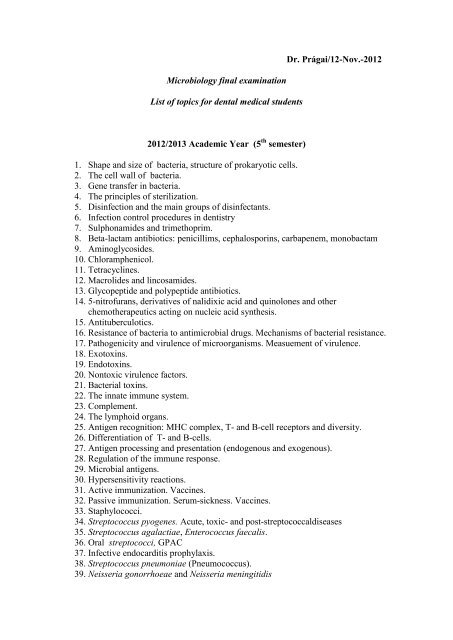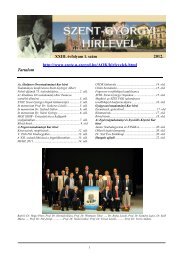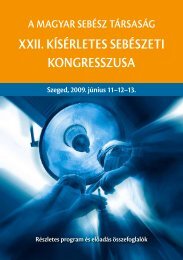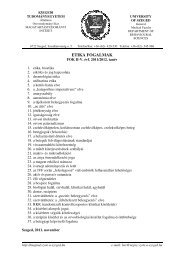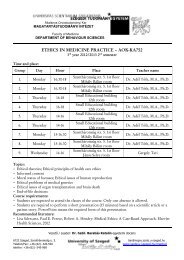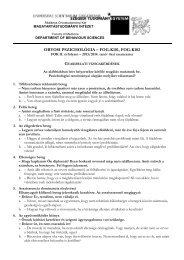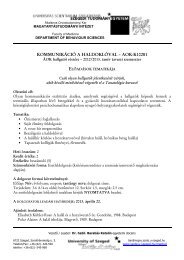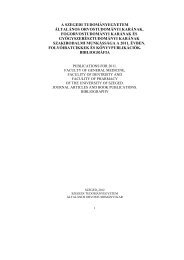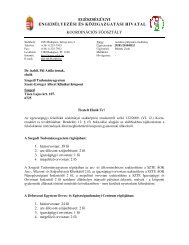Thesis topics
Thesis topics
Thesis topics
Create successful ePaper yourself
Turn your PDF publications into a flip-book with our unique Google optimized e-Paper software.
Microbiology final examination<br />
List of <strong>topics</strong> for dental medical students<br />
Dr. Prágai/12-Nov.-2012<br />
2012/2013 Academic Year (5 th semester)<br />
1. Shape and size of bacteria, structure of prokaryotic cells.<br />
2. The cell wall of bacteria.<br />
3. Gene transfer in bacteria.<br />
4. The principles of sterilization.<br />
5. Disinfection and the main groups of disinfectants.<br />
6. Infection control procedures in dentistry<br />
7. Sulphonamides and trimethoprim.<br />
8. Beta-lactam antibiotics: penicillims, cephalosporins, carbapenem, monobactam<br />
9. Aminoglycosides.<br />
10. Chloramphenicol.<br />
11. Tetracyclines.<br />
12. Macrolides and lincosamides.<br />
13. Glycopeptide and polypeptide antibiotics.<br />
14. 5-nitrofurans, derivatives of nalidixic acid and quinolones and other<br />
chemotherapeutics acting on nucleic acid synthesis.<br />
15. Antituberculotics.<br />
16. Resistance of bacteria to antimicrobial drugs. Mechanisms of bacterial resistance.<br />
17. Pathogenicity and virulence of microorganisms. Measuement of virulence.<br />
18. Exotoxins.<br />
19. Endotoxins.<br />
20. Nontoxic virulence factors.<br />
21. Bacterial toxins.<br />
22. The innate immune system.<br />
23. Complement.<br />
24. The lymphoid organs.<br />
25. Antigen recognition: MHC complex, T- and B-cell receptors and diversity.<br />
26. Differentiation of T- and B-cells.<br />
27. Antigen processing and presentation (endogenous and exogenous).<br />
28. Regulation of the immune response.<br />
29. Microbial antigens.<br />
30. Hypersensitivity reactions.<br />
31. Active immunization. Vaccines.<br />
32. Passive immunization. Serum-sickness. Vaccines.<br />
33. Staphylococci.<br />
34. Streptococcus pyogenes. Acute, toxic- and post-streptococcaldiseases<br />
35. Streptococcus agalactiae, Enterococcus faecalis.<br />
36. Oral streptococci, GPAC<br />
37. Infective endocarditis prophylaxis.<br />
38. Streptococcus pneumoniae (Pneumococcus).<br />
39. Neisseria gonorrhoeae and Neisseria meningitidis
40. Escherichia coli, Klebsiellae<br />
41. Salmonellae producing enteric fever.<br />
42. Enterocolitis producing Salmonellae.<br />
43. The Shigellae.<br />
44. Corynebacterium diphtheriae.<br />
45. Veillonella, Capnocytophaga<br />
46. Bordetella pertussis.<br />
47. Haemophilus influenzae, Legionella pneumophila<br />
48. Bacillus anthracis. Bacillus cereus.<br />
49. Histolitic Clostridia. Clostridium difficile.<br />
50. Neurotoxic Clostridia.<br />
51. Pseudomonas aeruginosa.<br />
52. Mycobacterium tuberculosis and Mycobacterium bovis.<br />
53. Atypical mycobacteria and Mycobacterium leprae.<br />
54. Actinomyces israelii<br />
55. Fusobacterium, Bacteroides.<br />
56. Relapsing fever: etiological agents and disease. Lyme disease.<br />
57. Treponema pallidum and other treponemas. Leptospirae.<br />
58. Mycoplasmas.<br />
59. Biological characteristics of Rickettsiae. The spotted fever group. Orientia<br />
tsutsugamushi.<br />
60. Rickettsiae of the typhus group. Coxiella burnetii, Leptotrichia<br />
61. Chlamydia trachomatis. Chlamydophila psittaci, Chlamydophila pneumoniae.<br />
62. Pathogenicity of viruses. Pathogenesis of viral diseases.<br />
63. Antiviral chemotherapy. Viral interference and interferon.<br />
64. Adenoviruses.<br />
65. Human ( ) herpesvirus 1 and 2.<br />
66. Human ( ) herpesvirus 3 (varicella-zoster virus).<br />
67. Human ( ) herpesvirus 5 /Cytomegalovirus/.<br />
68. Human ( ) herpesvirus 4 /Epstein-Barr virus/.<br />
69. Human herpesvirus 6, 7 and 8.<br />
70. Hepatitis virus B.<br />
71. Polioviruses, echoviruses and other enterovirus types (68-71)<br />
72. Coxsackie viruses. Rhinoviruses.<br />
73. Hepatitis A and E viruses.<br />
74. Congenital viral infections: Rubeolavirus, Cytomegalovirus.<br />
75. Orthomyxovirus influenzae.<br />
76. Parainfluenzae virus. Measles virus.<br />
77. Respiratory syncytial virus. Mumps virus.<br />
78. Rhabdoviruses.<br />
79. Characteristics of nonconventional viruses (prions) and prion diseases in human and<br />
in animal.<br />
80. Conventional slow virus infections.<br />
81. Hepatitis C (HCV) and Hepatitis Delta virus (HDV).<br />
82. The aetiology and epidemiology of AIDS.<br />
83. The pathomechanism and clinical manifestations and therapy of AIDS.<br />
84. Opportunistic infections in AIDS patients.<br />
85. Normal oral flora, the oral ecosystem and dental plaque.<br />
86. Microbiology of dental caries.<br />
87. Microbiology of periodontal diseases.
88. Oral mucosal infections: candidiasis, histoplasmosis, paracoccidioidomycosis,<br />
penicillosis.<br />
89. Preparation of bacterial smear, simple and Gram staining.<br />
90. Acid-fast staining, Neisser staining method<br />
91. Anaerobic cultivation. Antimicrobial susceptibility test.<br />
92. Serological reactions: precipitation, agglutination, complement fixation test.<br />
93. Antistreptolysin titer (ASO), CAMP test<br />
94. Lues serological diagnosis<br />
95. Skin tests: susceptibility and immunity tests.<br />
96. Trichomonas vaginalis, Trichomonas tenax<br />
97. Entamoeba gingivalis, Entamoeba histolytica, Entamoeba coli<br />
98. Ascaris lumbricoides, Trichuris trichiura<br />
99. Enterobius vermicularis, Trichinella spiralis<br />
100. Leishmania: L. donovani, L. brasiliensis, L. major, L. tropica, L. mexicana<br />
101. Toxoplama gondii<br />
102. Taenia solium, Taenia saginata<br />
103. Echinococcus granulosus, Echinococcus multilocularis


